
NOTE: THIS PAGE WAS TRANSLATED ENTIRELY BY COMPUTER AND THEREFORE WILL HAVE MANY ERRORS BUT IT HAS BEEN PLACED TO HELP THOSE THAT DON'T SPEAK PORTUGUESE UNDERSTAND THE BRAZILIAN REEF BALL PROJECT
The Reef Ball Development Group, Ltd. Index Page

An action plan for conservation of the marine bio-diversity and economic development of the coast of the State of the Paranã, Brazil using designed artificial reefs.


![]() With the management of the Institute
ECOPLAN and scientific control by the Center of Esfudos of the
Sea - CEM/UFPR, this Program will deploy daily pre-manufactured structures
of concrete with the objective to attract marine fish and organisms, creating
similar artificial ecosystems to rocky substrate, benefiting the activities
of diving, sport fishing and commercial fishing, while contributing to the
conservation of marine biodiversity. Some areas will be designated
as areas of protection.
With the management of the Institute
ECOPLAN and scientific control by the Center of Esfudos of the
Sea - CEM/UFPR, this Program will deploy daily pre-manufactured structures
of concrete with the objective to attract marine fish and organisms, creating
similar artificial ecosystems to rocky substrate, benefiting the activities
of diving, sport fishing and commercial fishing, while contributing to the
conservation of marine biodiversity. Some areas will be designated
as areas of protection.
The program will also use the best science to choose of the best places for the artificial reefs.
Stories of artificial reef use exist in Japan since 1600, on the hard substratrates submerged in coastal areas, creating surrounding artificial reefs of biological settling, objectifying the scanning of features fishing boats. The culture of marine clams (oysters, shellfishes) and of macroseaweed is based on the same principle and has been applied successfully, mainly in Asian countries. Currently, countries as Japan, Taiwan, Canada, United States, France and Portugal, are leaders in the practical one of sustainable handling of the coastal features through the implantation of artificial reef systems, objectifying the deep protection of the marine one against the impact of it fishes, or as artificial atratores of biological communities, aiming at the increase of fish place. These systems also are used as protection of the coastal environment against the erosion and destruction of constructions in the maritime edge. Ahead of the most diverse perspectives of coastal handling, the FAO (Food and Agriculture Organization ONU) recommends the artificial reef use for the interested coastal countries in exploring more adequately its features marine.
In the construction of the artificial reef systems quadrilateral structures of concrete had been used, with objective to protect reefs most delicate (Reef Ball™) against the drag networks. The system Reef Ball is based on the use of half-spherical structures of concrete developed by the American company " Reef Ball Development Group Ltd ", that it repassed this technology to Brazil, through
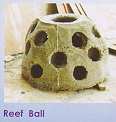

The Reef Ball™ resembles it one iglu, with diverse apertures of different sizes. Special cement (resistant the sulfotos), increased of microsilica is manufactured in mold of fidra of glass using itself, presenting bigger resistance and pH with values next to the ones to the marine environment, what it facilitates the fixing of the biological community, constituted of one varied fauna and flora. Besides being a good shelter for fish, the apertures of the Reef Balls™ keep the water stream allowing an efficient fixing in deep, excusing the poitas ones and knottings. The Reef Balls™ , besides being durable, not toxic and steady, is visually pleasant structures, contributing for the submarine paisagismo, and can still be used in set with sea scrap iron (ships), duly prepared for this function.
It was opted to the use of the technology Reef Ball™ and the quadrilateral structures of concrete to prevent the job of pollutant materials or with resistance and stability in the marine environment.
The use of inadequate materials is criticized in diverse countries that of them already had been used, for all bringing serious damages ace sea communities and the ecosystem of general mode. Amongst the main problems it can be cited: the contamination of the sea community for metals and other characteristic elements of scrap iron (oil, groxas, plastics, toxic inks, etc.) e to little durability of the structures.
For the construction of reefs of the program RAM they had been used material of high resistance and ambient quality (Cement Portland CP IV-RS 32) e, in set with specialists, they had been developed esfudos of resistance of materialais for the structures in concrete used in the program.
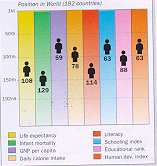
(Source World Reference Atlas,
1996)
It is given credit that the implementation of artificias reefs will bring, the medium and long run, an increase and conservation of sea biodiversity, preserving animal and vegetal species of the coastal region in areas of pla taforma (afostadas of the antropogênico impact); magnifying the fishing biomass for the increment of protection environments and food in abundance; controlling posca predatory with the creation of " runners of it fishes " and creating new alternatives to the artisan pecadores (it fishes of string, networks of wait and covos, among others), making possible still the implantation of systems of aquacultura in natural conditions, cultivating " in situ " value organisms comercicl (macroseaweed, clams, lobsters, octopuses, among others). The implantation of the Program RAM in its totality, that foresees the cniação of a great area with artificial reefs in the platform of the State of the Paraná, will still benefit the ecoturismo and the activities related to the diving and fish it esportiva, torando the more attractive paranaense coast to these activities. It will contribute still with clubs of it fishes, marinas and yacht clubs, that in very are benefited for the proximida one of of regions with good quality of water and satiated pespueiro feature

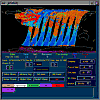

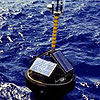
The cientificas activities also find an interesting field to be explored a time that the quadrilíteros artificial reefs, for its weight and format (1 x 1 x 0,8m weighing approximately 1 ton), represent excellent platforms of bracket for the oceanographical equipment fixing, aiming at the constant monitoramento of the oceanographical conditions in the platform. In structures criteriosamente selected será possible the safe equipment installation that they will supply given continuous of currents, temperature, salinity, masses d'água, waves of tide, mean sea level, concentration of clorofila and vertical stream of produced organic material in the zone of penetration of the light. These basic data are para the development of regional oceanographical porjetos and the ambient monitoramen to all the busy region for artificial reefs. The Program RAM exceeds the cientificas expectations and starts to represent a strategy of partner-economic importance for the development of the parancense coast. With the comments oblidas in the implantation of fose initial, it can be observed through the fish and organisms that já inhabit the reefs that the final results of the Design are still more promising.
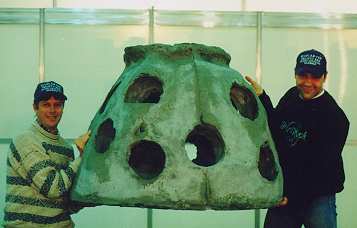 (Foam!)
(Foam!)


 (1st Reef Ball in Brazil!)
(1st Reef Ball in Brazil!)
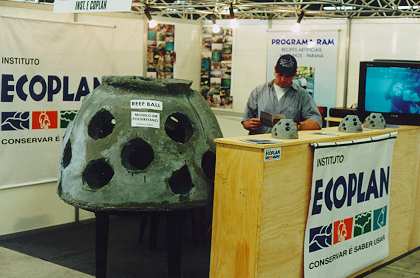 (Fishing Exibition)
(Fishing Exibition)


This page has been accessed times since 10/15/98
Copyright ©1995 & 1996, 1997, 1998. RBDG, Ltd. & ECOPLAN, all rights reserved. See brochure page footer for information on patents, copyrights, trademarks and service marks referenced, but not indicated, on this page.